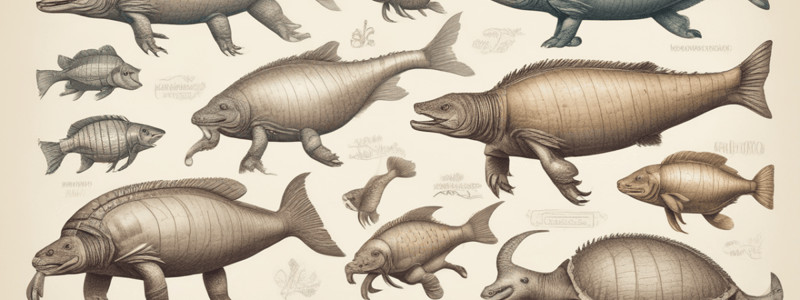Podcast
Questions and Answers
What is the primary reason scientists group, or classify, animals?
What is the primary reason scientists group, or classify, animals?
- To rank them according to their size
- To understand the habitat of each animal
- To make them easier to study (correct)
- To determine the diet of each animal
What is common to all vertebrates?
What is common to all vertebrates?
- Having a backbone and a brain
- Having feathers, fur, or hair
- Having an endoskeleton and scales
- Having a backbone, an endoskeleton, and some or all of the main systems (correct)
What is NOT a characteristic of vertebrates?
What is NOT a characteristic of vertebrates?
- Having a shell (correct)
- Having an endoskeleton
- Having a way to get waste out of the body
- Having a backbone
How many main groups do vertebrates get divided into?
How many main groups do vertebrates get divided into?
What is the smallest vertebrate mentioned in the passage?
What is the smallest vertebrate mentioned in the passage?
What is a characteristic that mammals have in common?
What is a characteristic that mammals have in common?
Why are reptiles considered cold-blooded?
Why are reptiles considered cold-blooded?
What do amphibians use to breathe oxygen?
What do amphibians use to breathe oxygen?
What is a characteristic that birds and mammals share?
What is a characteristic that birds and mammals share?
Why do scientists create smaller groups within the five main groups of vertebrates?
Why do scientists create smaller groups within the five main groups of vertebrates?
Flashcards
Why do scientists classify animals?
Why do scientists classify animals?
Scientists classify animals to organize them into groups based on shared characteristics. This makes it easier to study and understand the vast diversity of animal life.
What is a vertebrate?
What is a vertebrate?
A vertebrate is an animal with a backbone, an endoskeleton, and a set of essential organ systems. These systems include a brain, a circulatory system, and a digestive system.
What are the five main groups of vertebrates?
What are the five main groups of vertebrates?
The five main groups of vertebrates are: Fish, Amphibians, Reptiles, Birds, and Mammals. Each group has its own unique characteristics.
What makes mammals different?
What makes mammals different?
Signup and view all the flashcards
What are amphibians?
What are amphibians?
Signup and view all the flashcards
What defines reptiles?
What defines reptiles?
Signup and view all the flashcards
What makes birds unique?
What makes birds unique?
Signup and view all the flashcards
What is the difference between warm-blooded and cold-blooded animals?
What is the difference between warm-blooded and cold-blooded animals?
Signup and view all the flashcards
How do scientists create smaller groups within vertebrates?
How do scientists create smaller groups within vertebrates?
Signup and view all the flashcards
Study Notes
Grouping by Similarities
- Scientists group animals into categories to study them more easily, just like students are divided into different classrooms.
- The first division is between vertebrates (with a backbone) and invertebrates (without a backbone).
Characteristics of All Vertebrates
- Vertebrates have a backbone or spinal column.
- Vertebrates have an endoskeleton, which includes bones that give shape to the body.
- Vertebrates have various systems, including muscles, heart and blood, skin, waste removal, immunity, and a nervous system that controls the body.
Five Kinds of Vertebrates
- Vertebrates can be divided into five main groups: mammals, birds, fish, amphibians, and reptiles.
- Each group is determined by shared characteristics.
- There are at least 59,000 kinds of vertebrates on Earth.
Characteristics of Each Vertebrate Group
Mammals
- Warm-blooded, meaning they regulate their own body temperature.
- Have hair or fur.
- Have lungs for breathing air.
- Feed milk to their babies.
- Most give birth to live young, rather than laying eggs.
Birds
- Have feathers.
- Have two wings, although not all can fly.
- Are warm-blooded.
- Lay eggs.
Fish
- Have fins or scales.
- Live in water.
- Have gills for breathing oxygen.
Amphibians
- Have smooth, moist skin.
- Lay eggs in water.
- Most breathe through lungs and skin.
Reptiles
- Have scales.
- Are cold-blooded, meaning their body temperature changes with the environment.
- Breathe air.
- Most lay hard-shelled eggs on land.
Studying That Suits You
Use AI to generate personalized quizzes and flashcards to suit your learning preferences.
Description
Learn how scientists group animals into categories, including vertebrates and invertebrates, to make them easier to study and understand.




